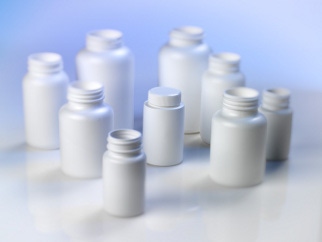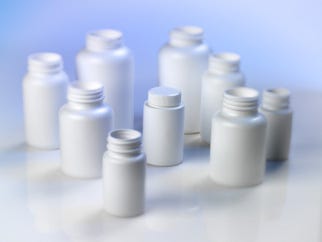New process cleans up bottle manufacturing
January 30, 2014


Amcor compression blow forming
Innovative products that truly change the way products are produced don't come along every day. But thanks to a partnership between Ann Arbor, MI-based Amcor Rigid Plastics and Italy's SACMI Imola S.C., a new technology is delivering a safer way to package pharmaceuticals.
The compression blow forming (CBF) machine produces rigid high-density polyethylene pharmaceutical bottles (HDPE), using compression molding and blow molding, which "is one of the most significant technological developments for rigid packaging in decades—it's a game-changer for an industry that demands risk-free performance," says Tod Eberle, vp, quality and engineering, for Amcor Rigid Plastics.
Developing this new technology was not a quick venture. SACMI originally developed the CBF process and, during a 14-month development project with Amcor, refined the technology specifically for pharmaceutical packaging. Amcor, under an exclusive agreement with SACMI, is using the CBF technology in select markets.
The company commissioned a 12-cavity platform that is producing HDPE over-the-counter and prescription bottles at the Amcor facility in Youngsville, NC. The company also has three more machines on order that will be in production by the end of the year, including a 20-cavity unit.
As the equipment evolves, it will have production capabilities not only for HDPE containers, but also for PP and PET containers. As of press time, however, SACMI was still in the process of developing the technology for these various materials.
High quality, low energy
The CBF process has key elements that set it apart from bottle injection blowing molding processes already in the market:
• Integrated quality systems offer vision inspection and leak detection.
• Continuous-motion operation reduces energy consumption, having eliminated the stopping and starting inherent with traditional injection bottle molding as the product moves from station to station.
• The system operates 30 deg. F cooler than other processes, which means less heat to remove after blowing, leading to improved cycle times and lower amounts of stress on the end product.
• The equipment also has a compacted footprint for a high output, or as Latricia Fry, market development manager for Amcor Rigid Plastics North America, explains, "The higher cavitation systems are the same footprint as the lower cavitation systems, which leads to operational efficiency."
Consistent product
Consistency in process and product from the start is a preeminent feature of this new technology. The compression blow forming machine's pre-blow process allows plastic separation from the compression core. Within less than a second of compressing the preform, the rotary motion and control actuation of the CBF begins, reducing the amount of plastic sticking to the metal core rod, and providing a more consistent wall thickness to the bottles. The lower heating process—along with no manifold for melt distribution to individual, separate cavities—means a decreased occurrence of resin burn and degradation. This in turn also means fewer black specs tainting the container.
Fry notes that there is improved consistency in bottle weight. In CBF processes, the extruded plastic is transferred directly into the compression mold, and a precision knife cuts the plastic over the barrel nozzle and vacuum transfer. The weight of the plastic is controlled for all cavities in the machine at one source point with a servo-controlled melt pump, and thus the system produces consistent lighter-weight packages.
The equipment also features secondary cooling on the exit conveyors, allowing bottles to be removed from the machine at hotter temperatures. This is a positive, Fry notes, because conveying the containers improves cycle times for the overall process.
The CBF process also has an inline quality inspection system. The infrared system can detect dimensional variations and contamination, including any embedded opaque or metal particles. The infrared camera system, she explains, is like an X-ray machine, with the ability to penetrate the bottle wall.
"This penetrated wall scan from the infrared camera is put through imaging filters to identify embedded contamination," Fry explains.
Additionally, the system performs two value-added processes: plasma surface treatment and leak detection. A plasma surface treatment system is in place for both label panel and finish sealing surface. Fry explains that the plasma surface treatment is performed with plasma guns that are similar to flame guns. However, an electrical current is discharged with ionized air flow to the surface of the bottles, creating the treatment. The leak testing is completed immediately after the bottle is blown, and is validated up to a 0.3 mm hole diameter.
Leading developments
Bringing a new technology to market can be both exciting and intimidating. Fry notes that partnering with SACMI to launch CBF in the pharmaceutical industry reaffirms Amcor's commitment to being an industry leader for rigid plastics, gives the company firsthand knowledge of the latest machine technologies available on the market. This also gives them the opportunity to have a direct influence on the design and overall capabilities of the machine.
But, she adds, "As with any new technology, significant resources are utilized to support the development of the machine and molds and validate key metrics."
Launching the CBF machine in the pharmaceutical packaging industry was a natural fit for Amcor, Fry continues. Bringing out new technologies that run less energy, use less waste and improve processes overall supports the company's sustainability efforts. The CBF's thermodynamic stability can produce bottles within 10 minutes from machine start-up.
And Fry says, "Due to the nature of the pharmaceutical market, including stringent quality control systems and expectations, CBF's improved bottle quality will allow Amcor to meet and exceed these demands."
While being first to market with a new technology is a check in the win column for Amcor and SACMI, those companies who use the new packaging process also win.
"Better individual bottle consistency as well as better bottle-to-bottle consistency creates the potential for improved fill line efficiencies and overall logistic efficiencies," Fry explains. Also, she adds, there is verified dimensional capabilities of 100 percent of the bottles made off the line.
While the process continues to evolve, Amcor and SACMI plan to develop new uses for it. The companies see a strong potential for CBF in various other markets, including HDPE single-serve dairy packaging.
Molly Strzelecki is a freelance writer and editor with extensive experience in the consumer packaged goods (CPG) industry and packaging converting business.
Amcor Rigid Plastics, 262-948-1874. www.amcor.com
SACMI Imola S.C., +39 542-607111. www.SACMI.it
.
About the Author(s)
You May Also Like


